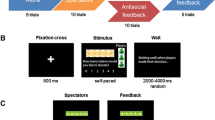Abstract
We examined the influence of sociometric status and the interactive effects of sociometric status and causal information on peers’ initial impressions of an unfamiliar child with autism. Children (N = 576) enrolled in regular education completed sociometric nominations and responded to videotapes of a child portraying autistic behavior. In contrast to sociometrically average and rejected children, neglected children reported more negative attitudes toward the child with autism and less willingness to engage in academic activities with him. Popular children did not differ from other sociometric groups on self-reported attitudes and behavioral intentions toward the child with autism. We predicted that popular children would be the most responsive to causal information about autism; however, rejected children reported more willingness to engage in activities with the child with autism in the presence of explanatory information when compared to other sociometric groups.
Similar content being viewed by others
References
Alderfer, M. A., Wiebe, D. J., and Hartmann, D. P. (2001). Social behaviour and illness information interact to influence the peer acceptance of children with chronic illness. Br. J. Health Psychol. 6: 243–255.
Brady, M. P., Shores, R. E., McEvoy, M. A., Ellis, D., and Fox, J. J. (1987). Increasing social interactions of severely handicapped autistic children. J. Autism Dev. Disord. 17: 375–390.
Campbell, J. M., Ferguson, J. E., Herzinger, C. V., Jackson, J. N., and Marino, C. (2004). Combined descriptive and explanatory information improves peers’ perceptions of autism. Res. Dev. Disabil. 25: 321–329.
Coie, J. D., and Dodge, K. A. (1983). Continuities and changes in children’s social status: A five-year longitudinal study. Merrill Palmer Q. 29: 261–282.
Crick, N., and Dodge, K. A. (1994). A review and reformulation of social information-processing mechanisms in children’s social adjustment. Psychol. Bull. 115: 74–101.
Frederickson, N. L., and Furnham, A. F. (1998). Sociometric classification methods in school peer groups: A comparative investigation. J. Child Psychol. Psychiatry 39: 921–933.
Georgia Department of Education (2002). The 2001–2002 Georgia Public Education Report Card. Retrieved June 2, 2003, from Georgia Public Education Report Card Online via http://accountability.doe.k12.ga.us/Report02/.
Harrower, J. K., and Dunlap, G. (2001). Including children with autism in general education classrooms: A review of effective strategies. Behav. Modif. 25: 762–784.
Jackson, L. D., and Bracken, B. A. (1998). Relationship between students’ social status and global and domain-specific self-concepts. J. Sch. Psychol. 36: 233–246.
Juvonen, J. (1992). Negative peer reactions from the perspective of the reactor. J. Educ. Psychol. 84: 314–321.
Lease, A. M., Kennedy, C. A., and Axelrod, J. L. (2002). Children’s social constructions of popularity. Soc. Dev. 11: 87–109.
Maag, J. W., Vasa, S. F., and Reid, R. (1995). Social and behavioral predictors of popular, rejected, and average children. Educ. Psychol. Meas. 55: 196–205.
MacKinnon-Lewis, C., Rabiner, D., and Starnes, R. (1999). Predicting boys’ social acceptance and aggression: The role of mother-child interactions and boys’ beliefs about peers. Dev. Psychol. 35: 632–639.
McGee, G. G., Almeida, M. C., Sulzer-Azaroff, B., and Feldman, R. S. (1992). Promoting reciprocal interactions via peer incidental teaching. J. Appl. Behav. Anal. 25: 117–126.
Morgan, S. B., Walker, M., Bieberich, A., and Bell, S. (1996). The Shared Activities Questionnaire. Unpublished manuscript, University of Memphis, Memphis, TN.
Newcomb, A. F., Bukowski, W. M., and Pattee, L. (1993). Children’s peer relations: A meta-analytic review of popular, rejected, neglected, controversial, and average sociometric status. Psychol. Bull. 113: 99–128.
Pierce, K., and Schreibman, L. (1995). Increasing complex social behaviors in children with autism: Effects of peer-implemented pivotal response training. J. Appl. Behav. Anal. 28: 285–295.
Rabiner, D. L., Keane, S. P., and MacKinnon-Lewis, C. (1993). Children’s beliefs about familiar and unfamiliar peers in relation to their sociometric status. Dev. Psychol. 29: 236–243.
Rogers, S. J. (2000). Interventions that facilitate socialization in children with autism. J. Autism Dev. Disord. 30: 399–409.
Sasso, G. A., and Rude, H. A. (1987). Unprogrammed effects of training high-status peers to interact with severely handicapped children. J. Appl. Behav. Anal. 20: 35–44.
Siperstein, G. N. (1980). Development of the Adjective Checklist: An Instrument for Measuring Children’s Attitudes Toward the Handicapped. Unpublished manuscript, University of Massachusetts, Boston.
Siperstein, G. N., and Bak, J. (1977). Instruments to Measure Children’s Attitudes Toward the Handicapped: Adjective Checklist and Activity Preference List. Unpublished manuscript, University of Massachusetts, Boston.
Siperstein, G. N., and Bak, J. J. (1985). Effects of social behavior on children’s attitudes toward their mildly and moderately mentally retarded peers. Am. J. Ment. Retard. 90: 319–327.
Strain, P. S., Kerr, M. M., and Ragland, E. U. (1979). Effects of peer-mediated social initiations and prompting/reinforcement procedures on the social behavior of autistic children. J. Autism Dev. Disord. 9: 41–54.
Swaim, K. F., and Morgan, S. B. (2001). Children’s attitudes and behavioral intentions toward a peer with autistic behaviors: Does a brief educational intervention have an effect? J. Autism Devel. Disorders 31: 195–205.
Terry, R., and Coie, J. D. (1991). A comparison of methods for defining sociometric status among children. Dev. Psychol. 27: 867–880.
White, K. J., Rubin, E. C., and Graczyk, P. A. (2002). Aggressive children’s perceptions of behaviorally similar peers: The influence of one’s own behavioral characteristics on perceptions of deviant peers. J. Soc. Pers. Relat. 19: 755–775.
Wiener, B. (1993). On sin versus sickness: A theory of perceived responsibility and social motivation. Am. Psychol. 48: 957–965.
Author information
Authors and Affiliations
Corresponding author
Rights and permissions
About this article
Cite this article
Campbell, J.M., Ferguson, J.E., Herzinger, C.V. et al. Peers’ Attitudes Toward Autism Differ Across Sociometric Groups: An Exploratory Investigation. J Dev Phys Disabil 17, 281–298 (2005). https://doi.org/10.1007/s10882-005-4386-8
Issue Date:
DOI: https://doi.org/10.1007/s10882-005-4386-8




